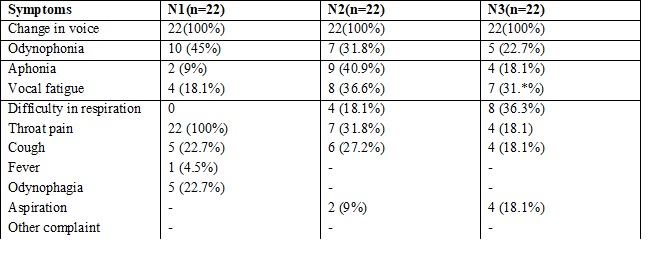Incidence of laryngeal complications associated with prolonged endotracheal intubation
Abstract
Introduction: Complications attributable to intubation increase morbidity and may increase the mortality rate.
Aim: The aim of this study was to evaluate laryngeal lesions in patients after prolonged intubation(˃24 h), to correlate these lesions with the variables involved in the process of intubation and to determine the risk factors.
Materials and methods: This is a prospective study of patients who were intubated for more than 24 h in ENT operation theatre and critical care unit. Patients underwent for laryngoscopy on the day of extubation, weekly after extubating for two weeks then monthly upto 6 months.
Results:66 patients were intubated in this study, laryngeal abnormalities were seen in most patients of all groups, on the day of extubation and only patients who undergone for prolonged intubation had abnormal finding a month after extubation.
Conclusion: At the end of one-month laryngeal findings were influenced only by the duration of intubation.
Downloads
References
2. Obrebowski A, Wojnowski W. Hoarseness resulting from post-intubation arytenoid cartilage subluxation in an 11-year-old girl. Otolaryngol Pol 1998;52:223-6.
3. Lundy DS, Casiano RR, Shatz D, et al. Laryngeal injuries after short- versus long-term intubation. J Voice. 1998 Sep;12(3):360-5.[pubmed]
4. Santos PM, Afrassiabi A, Weymuller EA Jr. et al. Risk factors associated with prolonged intubation and laryngeal injury. Otolaryngol Head Neck Surg. 1994 Oct;111(4):453-9.[pubmed]
5. Alessi DM, Hanson DG, Berci G. Bedside videolaryngoscopic assessment of intubation trauma. Annals of Otology Rhinology and Laryngology 1989;98:586-90.
6. Pontes P AL, De Biase N G, Gadelha E C. Clinical evolution of laryngeal granulomas: treatment and prognosis. Laryngoscope 1999;109:289–94.
7. Supance JS, Reilly JS, Doyle WJ, et al. Acquired subglottic stenosis following prolonged endotracheal intubation. A canine model. Arch Otolaryngol. 1982 Nov;108(11):727-31.[pubmed]
8. Whited RE. Posterior commissure stenosis post long-term intubation. Laryngoscope. 1983 Oct;93(10):1314-8.[pubmed]
9. Kastanos N, Estopá Miró R, Marín Perez A, Xaubet Mir A, Agustí-Vidal A. Laryngotracheal injury due to endotracheal intubation: incidence, evolution, and predisposing factors. A prospective long-term study. Crit Care Med. 1983 May;11(5):362–7.[pubmed]
10. Gaynor EB, Greenberg SB. Untoward sequelae of prolonged intubation. Laryngoscope. 1985 Dec;95(12):1461-7.[pubmed]
11. Brandwein M, Abramson AL, Shikowitz MJ. Bilateral vocal cord paralysis following endotracheal intubation. Arch Otolaryngol Head Neck Surg. 1986 Aug;112(8):877-82.

Copyright (c) 2018 Author (s). Published by Siddharth Health Research and Social Welfare Society

This work is licensed under a Creative Commons Attribution 4.0 International License.


 OAI - Open Archives Initiative
OAI - Open Archives Initiative



















 Therapoid
Therapoid

